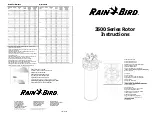
9
Using the Vacuum Control and Gauge
1. Place the SPE columns in the needle ports and add solvent
or sample to the column reservoirs.
2. Open the stopcocks if they are being used.
3. Open both the coarse and fine vacuum control valves on
the VacMaster lid. The coarse control valve is open when it
is turned counter-clockwise. The fine control valve is open
when turned fully counter-clockwise.
4. Apply vacuum to the VacMaster manifold from the
vacuum source.
5. Close the coarse vacuum control valve by turning clockwise.
6. Adjust the vacuum by turning the fine control valve clockwise
until the desired vacuum level and flow rate is obtained.
Monitor the vacuum level on the vacuum gauge next to the
control valves. A vacuum level of minus 3 to minus 5" of Hg is
satisfactory for most applications. Establishing the vacuum
level needed for optimum flow rates through the SPE column
is an important part of every method development procedure.
Warning
»
Do not exceed minus 20" Hg (-0.68 bar) at any time. Vacuum
levels above minus 20" Hg significantly increase the risk of
implosion of the glass tank and serious personal harm.
7. If stopcocks are being used on the needle ports, the flow
rate through each SPE column can be individually regulated
by the stopcock position.
8. When the desired volume of solvent or sample is drawn
through the tube:
a. Close each stopcock if they are being used.
b. Open the fine control valve by turning it
counter-clockwise.
c. Open the coarse control valve by turning it
counter-clockwise.
d. Turn off the vacuum source.
9. Continue the processing by adding the next solution to each
SPE column reservoir. Repeat procedure from step 2 above.
Using the Waste Outlet Fitting
The waste outlet fitting inside the glass tank of VacMaster can
be oriented in two positions. When the fitting is positioned so
the drain tube is up, liquid collects in the tank. When the fitting
is turned down, any liquid that reaches the drain tube will be
removed by vacuum from the tank through the outlet fitting.
A collection flask in the vacuum line is essential with the outlet
fitting in this orientation to collect the evacuated liquid.
Without a trap, the liquid would enter the vacuum pump and
could damage the pump.
Using Biotage
®
VacMaster
™
with
Biological or Hazardous Materials
When processing physiological fluids, tissues, environmental,
or other hazardous samples, it is advantageous to purchase a
second low cost tank to dedicate to the analyte elution step.
This second tank can remain uncontaminated. A single vacuum
source can be used by placing a PTFE T-valve in the vacuum line
between the vacuum source and each manifold. The first tank
can be used without a collection tube rack to collect the liquids
exiting the columns during sample application and interference
elution steps. By turning the waste outlet fitting up, liquids
will remain in the tank. An appropriate sterilization solution
(for example bleach) can be added to the tank to neutralize
the collected biological liquids. Swivel the fitting down to
direct the waste fluids out of the tank into a collection flask for
proper disposal, or pour the waste fluids from the tank into the
appropriate waste container.
After the samples have been loaded on the SPE columns and
the interferences have been eluted, the VacMaster lid can be
removed from the first tank and placed on the second tank.
Then the samples can be eluted into collection tubes in the
clean second tank.
Routine Operation
Routine Operation
Содержание VacMaster 10
Страница 1: ...Biotage VacMaster 10 20 Sample Processing Manifold User Manual ...
Страница 14: ......
Страница 15: ......


































